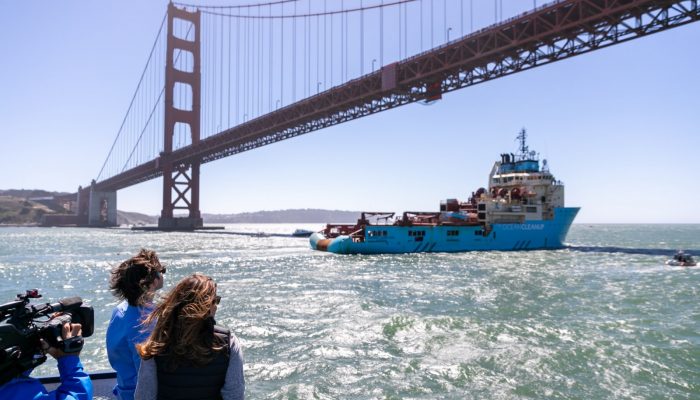
The urgency around many sustainability issues leads some billionaire investors to throw caution in the wind, frustrated with the pace of academic research. Robert Emberson sympathises with private projects like the Ocean Cleanup, even when things go wrong. ‘How’, he asks, ‘might we build a constructive bridge between ambitious entrepreneurs and scientific sceptics? ‘
Reading and writing about sustainable development in 2019 can be tough going, with a seemingly unending series of headlines suggesting that we as a society are lagging behind in the race to achieve our goals and that the deleterious effects of climate change are looming closer and closer, if not already upon us.
So when good news of any kind comes along, it can often be something to cling to – and perhaps even more devastating if that news is not what it seems. This up and down emotional trajectory describes my response to the clean-up operation launched last year to remove the plastic waste from the ‘Great Pacific Garbage Patch’, which ran into difficulties early this year.
The story is not yet over, though, and there are lessons to be learned for scientists working on issues related to sustainability more generally – so perhaps a positive outcome is still to come.
For those unaware, plastic pollution, both small and large, often ends up in the ocean, where gyres – or ocean currents – preferentially carry the waste products to certain areas, where it accumulates. These patches are hard to delineate, since unlike the images of islands of plastic bottles and grocery bags sometimes portrayed in the media, the plastic concentration is relatively low (4 particles per cubic metre), but the patch – which may be as large as 15,000,000 square kilometres – likely represents the largest waste accumulation in the ocean.
The open ocean, while home to diverse ecosystems and vitally important to many food networks, is a challenging thing to govern. Since it is not owned by any given country, the responsibility to clean up waste accumulating within the seas is nigh on impossible to assign. It’s a classic problem of ‘the commons’ – shared resources, like the ocean or the atmosphere, that many users need but none own, can be overexploited and depleted. Resolving those issues can be challenging at best.
For some scientists, problems with the system had been evident from the start
So, in 2012, enter the Ocean Cleanup Project. At a TED talk, the 18-year-old inventor Boyan Slat laid out a plan to use floating booms to gradually gather up the waste in an efficient manner. Investors were intrigued, and the project took off quickly; billionaires funding it allowed for it to be deployed in mid-2018, rapid progress by any standard. The clean-up attempt had begun in earnest.
Quickly, though, problems arose; the system of floating booms couldn’t withstand the storms in the open ocean, and by January 2019 the first clean-up system had been towed to Hawaii for repairs after teething problems.
For some scientists, problems with the system had been evident from the start. Kim Martini and Miriam Goldstein, research oceanographers unaffiliated with the project, analysed the project and found major issues. While there was communication between the scientists and the engineers involved with the project, and some of the issues raised were addressed, the two oceanographers still maintained that while the aim was laudable, the design was not as accomplished. Despite this, the project went ahead, and the concerns of the scientists proved to be well founded.
Clearly, this is a well-intentioned project. But perhaps just as clear is that a communications gulf existed between the scientists and the project developers. And therein lies the key question: how can scientists involved in sustainability issues best communicate their thoughts to private sector projects aiming to solve those issues? It certainly seems unlikely that the Ocean Cleanup will be the last case where such communication matters.
Indeed, it’s not surprising that in some cases private investors and entrepreneurs have stepped in with big ideas to solve problems of the commons. It’s clear that in many cases billionaires have lofty ambitions beyond the business that made them rich – both Jeff Bezos at Amazon at Tesla’s Elon Musk have moved into space exploration, and for individuals with such a mindset the idea of ‘saving the world’ might well appeal. They may also consider themselves less limited by regulation and national borders than scientists and government.
In fact, there’s more than just regulation and borders that hold back some ideas. The precautionary principle, both in unwritten and legal contexts, prevents some action where it is unclear if that action could result in harm to the public. This is often applied to geoengineering ideas, since the long-term implications may not be well known. A private project to dump iron sulphate into the ocean to encourage plankton growth and thus a draw-down of Carbon Dioxide in 2012 was cited as falling foul of these principles, having not established the long-term risk of seeding the ocean in this way.
The slower pace of academic research, …, makes it ever more appealing for private individuals to skip those steps and spend a fortune to fix something now, rather than wait until it’s too late
At the same time, however, there is an increasing sense of urgency around many sustainability questions. The slower pace of academic research, the painstaking process of ensuring reproducibility in findings, and the need to establish long term effects of potential solutions to climate or sustainability issues makes it ever more appealing for private individuals to skip those steps and spend a fortune to fix something now, rather than wait until it’s too late.
I can sympathise with that view. It’s well-meaning, and solving a problem is better than sitting on the sidelines, or worse profiting from it. Moreover, hindsight is 20:20, so if a solution only becomes problematic after it is deployed, then those behind it can always argue that they did what they could in advance. That must be balanced though with an abundance of caution, and perhaps this is where scientists can help.
I would argue that we should be realistic – solutions will come from all sectors of society, and private individuals and entrepreneurs may well be the ones leading the charge. While it shouldn’t be incumbent upon research scientists alone to ensure their voices are heard by private projects, we shouldn’t shy away; building bridges, especially in the form of communication channels, would be of great benefit. Goldstein and Martini did a great service to science by reaching out and making their voices heard, even if they might have been perceived as naysayers.
We might not be able to change the minds of those leading private initiatives, but we can at least provide them with the most information possible to make their decisions.
Robert Emberson is a Postdoctoral Fellow at NASA Goddard Space Flight Center, and a science writer when possible. He can be contacted either on Twitter (@RobertEmberson) or via his website robertemberson.com


